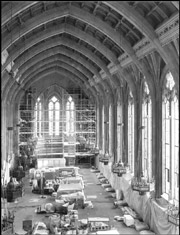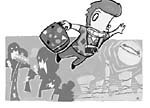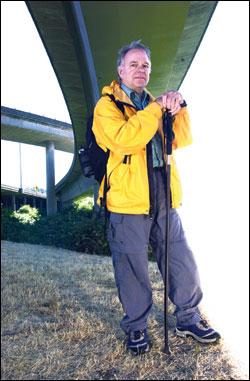SUZZALLO LIBRARY
University of Washington Campus, 7:30 a.m.-10 p.m. Mon.-Thurs.; 7:30 a.m.-6 p.m. Fri.; 9 a.m.-5 p.m. Sat.; noon-10 p.m. Sun. through Thurs., Dec. 19.
ARCHITECTURE HAS the power to mess with our heads, to remodel our behavior, for better or worse. You can see it in action if you hang around outside EMP for an hour and watch people jaywalk like crazy—right in the heart of Seattle, normally the City of the Immaculate Pedestrian.
Betsy Wilson, director of UW Libraries, tells a different kind of story about the power of Suzzallo Library, just reopened after a two-year, $47 million seismic reinforcing and restorative scrubbing. One evening in 1942, a Japanese-American student named Gordon Hirabayashi was studying alongside his white classmates in the vast and awesome second-floor reading room. As the 8 p.m. curfew for Japanese-Americans approached, he packed up and left, as usual. Somewhere between the library and his dorm, his sense of injustice boiled over and he turned around, returning to the library in silent protest. Eventually his resistance led to prison. (The conviction was overturned in 1987.)
Hang around inside this room for an hour, and it’s the easiest thing in the world to conclude that it had somehow infused Hirabayashi with nobility, pouring intellectual integrity or moral courage into him. Great spaces do such things. “The reading room has this wonderful uplifting power,” says Wilson. “It pulls you outside of yourself.”
It does. And it’s worth asking why, because the answers figure into the nature of the public buildings we want in Seattle.
Suzzallo’s architect, Carl F. Gould, was a conservative designer—until late in his career he typically raided the past for his inspiration. But he was ambitious and passionately idealistic. Beauty, he insisted, “is the very soul of our profession.”
GOULD ARRIVED IN Seattle in 1908 and began educating what was still a rawboned boomtown in the ways of beauty as he understood it. He designed The Rainier Club, the 1932 Seattle Art Museum in Volunteer Park (now the Asian Art Museum), and more than 50 houses, including Bill Boeing’s. Suzzallo, completed in 1926, was his magnum opus.
He founded UW’s Department of Architecture in 1914, and his firm of Bebb & Gould, serving as official university architects, ordained English Gothic as the new campus style. It was a contrivance to graft the visual gravity of Oxford and the Ivy League onto the upstart Seattle school, but it also happened to offer a practical advantage. Gould’s biographers, T. William Booth and William H. Wilson, point out that a 20th-century concrete-and-steel structure can hide nicely inside Gothic buttresses, allowing amazingly large windows between the load-bearing bones of a building. Since libraries need daylight, especially here, Gothic was almost a rational choice.
Its reading room, however, is gloriously, stunningly irrational. It’s a cathedral of books—240 feet long, 52 feet wide, and 65 feet high—crowned by a transverse-arched ceiling stamped endlessly with kaleidoscopic medallions. It squanders space so lavishly that only 17,000 books line the walls—fewer than a tenth of your average Barnes & Noble. It would make a more practical concert hall than library, where all that empty air could be put to work making useful reverb time.
But all that space soaring overhead, defined by meticulous detailing and flooded with diffused daylight (and 22 chandeliers after sundown), is an emotional rush. Gould was no na僚 he staged it. In a 1926 diary entry he muses that the space imparts “the impression of something higher than the individual” that “aids in detaching the mind from incidental thinking.” There’s authority in the Gothic air, too. You don’t have to be an architecture junkie to feel the weight of centuries here, stretching back through America’s European roots to medieval monks ponderously amassing knowledge (and keeping it away from the peasants). And if there’s a dance of cognitive dissonance in the room’s imagery (church) and its function (reasoning), well, Oxford has the same problem.
ALL GREAT ARCHITECTS eventually figure it out: interiors are more important than exteriors—they’re why buildings are buildings and not just big lawn ornaments. Frank Lloyd Wright was fond of quoting Lao Tzu: “The reality of the vessel is the void within it.” The reality of Suzzallo’s void is that it palpably celebrates human achievement and intelligence. You walk in and you shiver first with delight, then responsibility. The room expects something, and not only of you. A vast space unites people in a collective purpose. A collection of fragmented spaces, like EMP, can’t do that.
Few new public buildings of any kind today even try to provide big, dramatic spaces. Urban train stations once celebrated the audacity of travel, but airport terminals seem to punish it. City halls, once symbols of civic pride, now had better look like Scrooge’s file cabinets to prove that government is using our tax money efficiently. Star architect Steven Holl calls his new Bellevue Art Museum an “art barn,” proudly enough. Most new churches look like suburban community centers, which is what they are. The magic show is over.
Wilson says that few libraries today are daring to build spaces for inspiration alone. (If it’s impossible to measure, it’s impossible to justify.) However, the new Seattle Central Library promises a dramatic reading room on the eighth floor with nearly the footprint of Suzzallo’s (50 by 200 feet) and a view of Elliott Bay. Judgment will have to wait until it’s finished.
Betsy Wilson has been checking in on Suzzallo’s reading room nearly every day since its Sept. 30 opening, and she has another story about how students work in there. “The acoustics are so good that using a laptop becomes really obtrusive,” she reports. “When a student starts to use one, someone else will say, ‘Could you please take that outside?’ We haven’t made a rule about it; they seem to police themselves. With all our technology, there’s a longing for that kind of place. It’s kind of the last sanctuary for quiet thought.”








